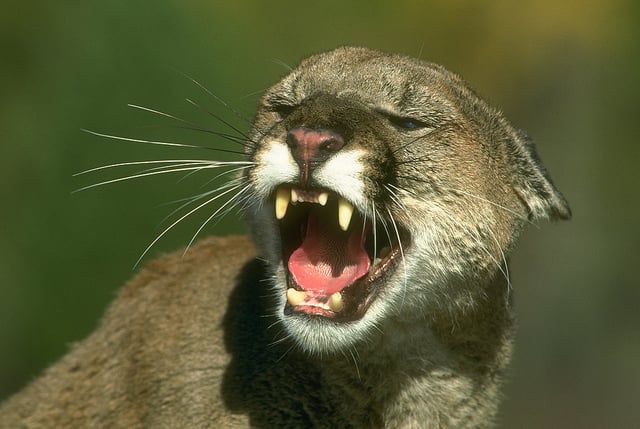Puma. Painter. Panther. Cougar. Catamount. El Leon. Ghost cat.
With 18 native South American names, 25 Native American names, and 40 English names, this big cat has a big list of sobriquets that all boil down to the same thing: mountain lion. It was hunted to extinction last century, but throughout the Blue Ridge, there are claims from locals that the cat has returned. The folks with the U.S. Fish and Wildlife Service help set the record straight.
The last confirmed records of the Eastern Cougar’s existence were in 1938 in Maine.
Though the government states the species is extinct, hundreds of sightings are still reported on a daily basis, particularly after the 2011 sighting of an Eastern mountain lion in Greenwich, Conn. The cougar had voyaged nearly 1,500 miles from his home in the Black Hills of South Dakota, an incredible feat no doubt, but one that exemplifies the big cat’s dispersal instincts. Although the lone wanderer met a tragic fate on the Wilbur Cross Parkway, his legacy spurred a phenomenon of conspiracy theories. Determined big cat activists have been trying to deceive state Fish and Wildlife Service agencies with false sightings and photographs from the Internet.

“We’re really vulnerable to these hoaxes,” says biologist Tom French of the Massachusetts Fish and Wildlife Service. “The people behind these deliberate scams claim that the state government has been keeping mountain lions a secret. We’re not that good. There’s no way in hell we could have kept that quiet.”
Whether the “sightings” are hoaxes or genuine inquiries is irrelevant. If the Eastern mountain lion is extinct, what are these people seeing?
“We get a lot of photographs from trail cameras that are actually domestic cats,” says Asheville-based Fish and Wildlife biologist Mark Cantrell.
Others have confused the Eastern mountain lion with coyotes, bobcats, or even deer. Misidentification is typically caused by poor lighting conditions at the time of the sighting.
[button color=”white” size=”normal” alignment=”none” rel=”follow” openin=”newwindow” url=”http://newschannel9.com/video-more-tennessee-cougar-encounters-dna-tests-confirm-a-female”]This video footage of a confirmed female lion was captured in November 2015 in Obion County, Tennessee.[/button]
“Fortunately, with the availability of cell cameras, we’re able to see more and more what people were just verbally reporting before,” says French. As a result, the Fish and Wildlife Service believes it has largely debunked local lore on the elusive cat.
“The Eastern cougar was once a big predator in the Blue Ridge,” Cantrell says. “But like any big predator in this region, their story is one of demise and loss since the first settlers came. Now, it is genetically and geographically extinct.”
That doesn’t mean that cougars cannot, and will not, make their rare appearances in the Blue Ridge.
One subspecies of the cougar lives on in the East, although it, too, is in danger of becoming extinct altogether. The Florida panther typically roams in the south of Florida, but the occasional dispersing cat has found its way into Georgia and parts of Alabama. These days, the Florida panther’s numbers are down to fewer than 200 despite the state’s protection efforts.
Aside from the chance Florida panther making its way to the Blue Ridge, Cantrell says that Fish and Wildlife does come across the occasional cougar that has escaped from captivity, either from a zoo or the home of a negligent pet owner, but that’s not reason enough for people to think the puma population is back.
“I think the number of dispersing cats from these other populations could eventually, if left alone, develop a population,” Cantrell says. “That’s just a matter of time. Because of the fragmentation of the Southeast, I feel that the Blue Ridge is the only place where a mountain lion population could really develop.”
French agrees, although he says the prospect of reintroducing the species into the area would likely encounter some opposition, particularly from livestock owners.
“We’re scared of what we don’t know,” French says. “We have plotted models for mountain lion habitats, usually in areas with fairly big pieces of forest and good numbers of deer,” but those models, and the overwhelming increase in the deer population, aren’t enough to convince the general population.
“The overarching concern is whether it would be universally accepted by the folks who live, work, and play in the Blue Ridge,” says Cantrell. So far, the general consensus has been no.
Know It When You See It
- Characteristics: slender body, round head, pointed ears, long tail
- Length: (nose to tail) 5 to 9 feet
- Weight: 100-150 pounds
- Color: Tawny brown, lighter on underside
- Tracks: Four toes up front, three lobes on heel pad, claw marks do not show
- Kill strategy: stealth; attacks back of the neck
- Eats: Primarily deer
- Litter: 1-4 cubs
What To Do When You Come Across a Cat
- STOP.
- Don’t run.
- Don’t play dead.
- Don’t make sudden movements.
- Maintain eye contact.
- Stand tall.
- Look big.
- Speak firmly.
- Throw items near the lion.







